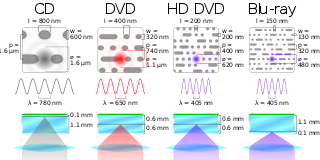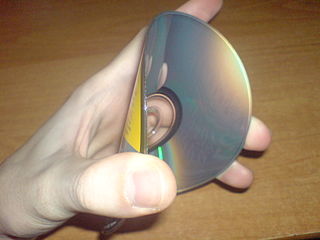
An optical disc is a flat, usually disc-shaped object that stores information in the form of physical variations on its surface that can be read with the aid of a beam of light. Optical discs can be reflective, where the light source and detector are on the same side of the disc, or transmissive, where light shines through the disc to be detected on the other side.

In computing, an optical disc drive is a disc drive that uses laser light or electromagnetic waves within or near the visible light spectrum as part of the process of reading or writing data to or from optical discs. Some drives can only read from certain discs, but recent drives can both read and record, also called burners or writers. Compact discs, DVDs, and Blu-ray discs are common types of optical media which can be read and recorded by such drives.

The enhanced versatile disc (EVD) is an optical-medium-based digital audio/video format, developed by Beijing E-World, as a rival to the DVD to avoid the high royalty costs associated with the DVD format. Its development was supported by the Chinese government. While it was intended to replace the DVD standard in China by 2008, the format had failed to gain traction and ultimately faded into obsolescence.

DVD-RAM is a DVD-based disc specification presented in 1996 by the DVD Forum, which specifies rewritable DVD-RAM media and the appropriate DVD writers. DVD-RAM media have been used in computers as well as camcorders and personal video recorders since 1998.

MiniDVD or 8 cm DVD is a DVD disc with a reduced diameter of 8 centimetres (3.15 in). It has been most commonly used in camcorders due to its compact size. The most common MiniDVDs are single layered and hold 1.4 GB of data, but there are variants that can offer up to 5.2 GB of storage space, through a combination of dual layers and dual sides.

Versatile Multilayer Disc was a high-capacity red-laser optical disc technology designed by New Medium Enterprises, Inc. VMD was intended to compete with the blue-laser Blu-ray Disc and HD DVD formats and had an initial capacity of up to 30GB per side. At a physical level, VMD is identical to DVD, but with the possibility of using more layers.

The Holographic Versatile Disc (HVD) is an optical disc technology that was expected to store up to several terabytes of data on an optical disc 10 cm or 12 cm in diameter. Its development commenced in April 2004, but it never arrived due to lack of funding. The company responsible for HVD went bankrupt in 2010.
MultiLevel Recording was a technology originally developed by Optex Corporation and promoted by Calimetrics to increase the storage capacity of optical discs. It failed to establish itself on the market. Through a combination of proprietary media, recorder, reader and player modifications, Calimetrics proposed that ML could increase the capacity of a CD-ROM, CD-R or CD-RW to 2 GB, a single-layer DVD, DVD-R, DVD+R, DVD-RW, DVD+RW or DVD-RAM to 7.1 to 10 GB and a single-layer Blu-ray Disc (BD) to as much as 60 GB. An optionally integrated Digital Rights Management (DRM) system entitled MovieGuard was also suggested. An industry group called the ML Alliance was formed in 2000 to help commercialize ML technology. Members eventually included Calimetrics, TDK, Sanyo Semiconductor, Plextor, Matsushita Kotobuki Electronics, Mitsubishi Chemical Corporation, Verbatim, Teac and Yamaha.

Professional Disc (PFD) is a digital recording optical disc format introduced by Sony in 2003 primarily for XDCAM, its tapeless camcorder system. It was one of the first optical formats to utilize a blue laser, which allowed for a higher density of data to be stored on optical media compared to infrared laser technology used in the CD and red laser technology used in the DVD format.

Optical storage refers to a class of data storage systems that use light to read or write data to an underlying optical media. Although a number of optical formats have been used over time, the most common examples are optical disks like the compact disc (CD) and DVD. Reading and writing methods have also varied over time, but most modern systems as of 2023 use lasers as the light source and use it both for reading and writing to the discs. Britannica notes that it "uses low-power laser beams to record and retrieve digital (binary) data."

DVD recordable and DVD rewritable are optical disc recording technologies. Both terms describe DVD optical discs that can be written to by a DVD recorder, whereas only 'rewritable' discs are able to erase and rewrite data. Data is written ('burned') to the disc by a laser, rather than the data being 'pressed' onto the disc during manufacture, like a DVD-ROM. Pressing is used in mass production, primarily for the distribution of home video.
Calimetrics was an American technology company founded in 1994 by Terrence Wong, Michael O'Neill, and Thomas Burke. Based on Dr. Wong and Dr. O'Neill's UC Berkeley research, the company received startup funding of $1.8M from an Advanced Technology Program grant to conduct research and development on pit-depth modulated optical data storage systems. Over the years, Calimetrics raised approximately $50M from government, venture, angel, and corporate sources. Calimetrics was acquired in 2003 by LSI Logic and ceased operations in 2004.

This article compares the technical specifications of multiple high-definition formats, including HD DVD and Blu-ray Disc; two mutually incompatible, high-definition optical disc formats that, beginning in 2006, attempted to improve upon and eventually replace the DVD standard. The two formats remained in a format war until February 19, 2008, when Toshiba, HD DVD's creator, announced plans to cease development, manufacturing and marketing of HD DVD players and recorders.

The Stacked Volumetric Optical Disc is an optical disc format developed by Hitachi Maxell, which uses an array of wafer-thin optical discs to allow data storage.

The DVD is a digital optical disc data storage format. It was invented and developed in 1995 and first released on November 1, 1996, in Japan. The medium can store any kind of digital data and has been widely used for video programs or formerly for storing software and other computer files as well. DVDs offer significantly higher storage capacity than compact discs (CD) while having the same dimensions. A standard single-layer DVD can store up to 4.7 GB of data, a dual-layer DVD up to 8.5 GB. Variants can store up to a maximum of 17.08 GB.

Blu-ray is a digital optical disc data storage format designed to supersede the DVD format. It was invented and developed in 2005 and released worldwide on June 20, 2006, capable of storing several hours of high-definition video. The main application of Blu-ray is as a medium for video material such as feature films and for the physical distribution of video games for the PlayStation 3, PlayStation 4, PlayStation 5, Xbox One, and Xbox Series X. The name refers to the blue laser used to read the disc, which allows information to be stored at a greater density than is possible with the longer-wavelength red laser used for DVDs.

HD DVD is an obsolete high-density optical disc format for storing data and playback of high-definition video. Supported principally by Toshiba, HD DVD was envisioned to be the successor to the standard DVD format, but lost to Blu-ray, supported by Sony and others.

VCDHD is an optical disc standard, similar to CD or DVD. The technology for VCDHD was invented with in: Japan, the Netherlands and Poland. Since the name of the technology is similar to the arbitrarily inferior VCD, it's also marketed using the name DVHD.

LS-R, or the Layer-Selection-Type Recordable Optical Disk, is the term coined by Hitachi in 2003 for a next-generation optical disc technology which allows much larger data storage densities than DVD, HD DVD or Blu-ray Disc, by allowing the use of many data layers in a single disc. In previous optical disc technologies, relatively few data layers can be incorporated in a single disc, since the reflections from the different layers interfere with each other. However, in LS-R, only the layer of interest generates a reflection, meaning that very many layers can theoretically be stacked in the same disc. This feat is accomplished by an electronic "selection" mechanism, whereby each data layer is coated with electrodes and only the electrodes associated with the layer of interest are activated. This activation changes the "selected" data layer from being transparent to being reflective or opaque, thus it can be addressed.

A CD-ROM is a type of read-only memory consisting of a pre-pressed optical compact disc that contains data. Computers can read—but not write or erase—CD-ROMs. Some CDs, called enhanced CDs, hold both computer data and audio with the latter capable of being played on a CD player, while data is only usable on a computer.












